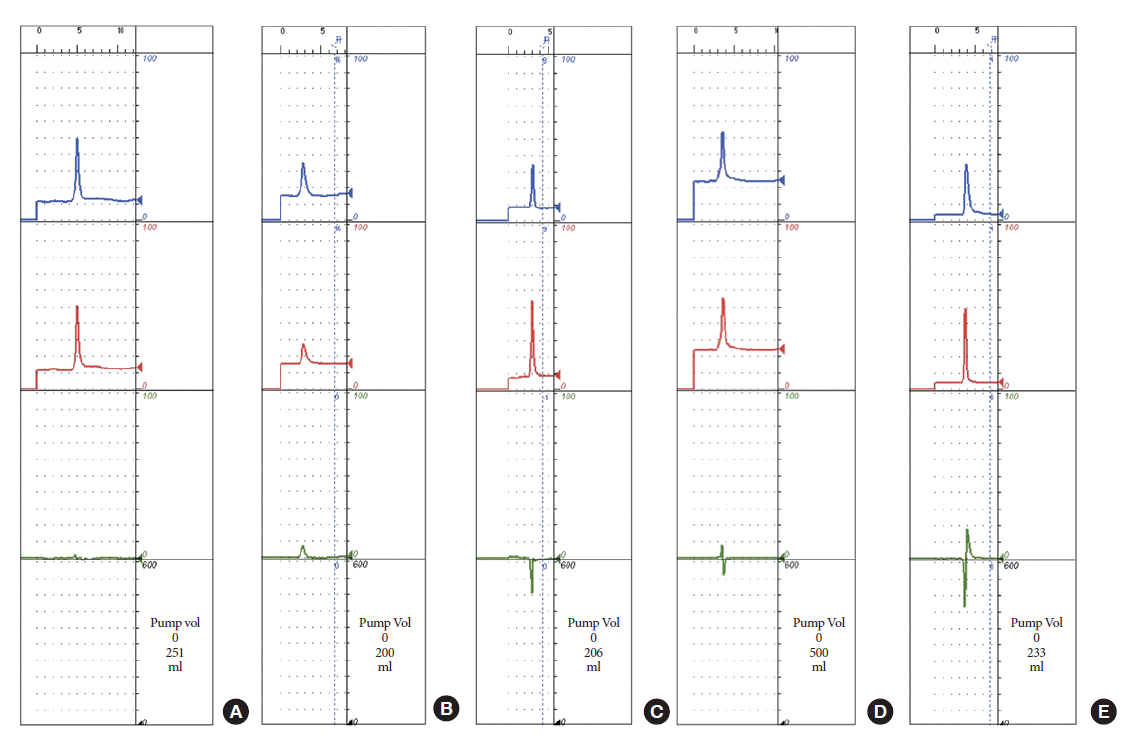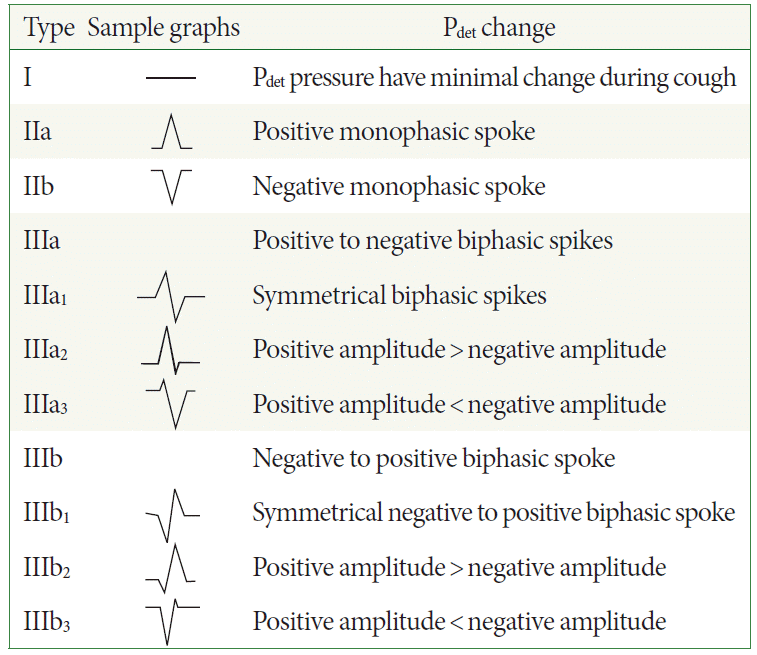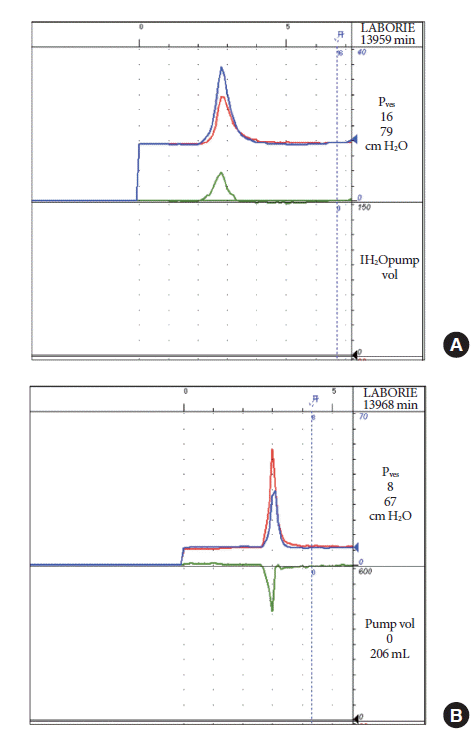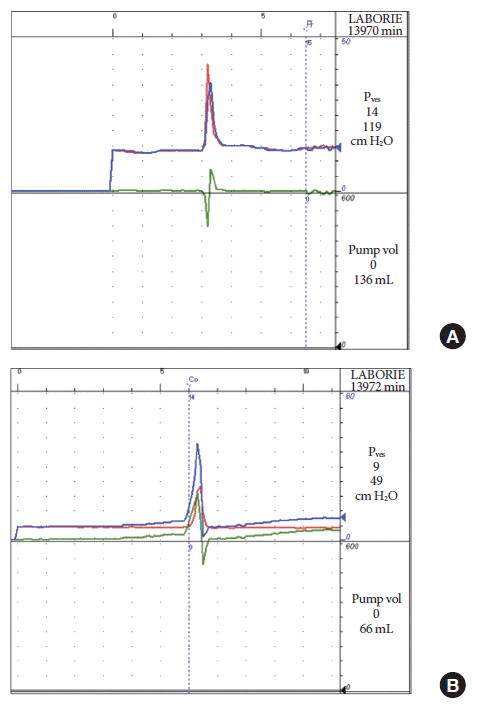Initial Cough Pressure Values and TVRs
As abdominal strength differs among individuals, the P
ves and P
abd values during the initial cough varied widely. Another reason for the wide range of pressures is that most of the neurogenic bladder patients in our center had a history of spinal cord injury. Abdominal muscle strength decreases in patients with a spinal cord injury above the thoracic level, which leads to decreased P
ves and P
abd values during coughing. Some highlevel spinal cord injury patients cannot even cough. We observed that the 95% range of the cough amplitude for P
ves and P
abd were 4ŌĆō62 and 3ŌĆō70 cm H
2O, respectively, in the supine position and 9ŌĆō95 and 8ŌĆō98 cm H
2O, respectively, in the sitting position among neurogenic patients. The lower extent of those ranges is less than the value of 15 cm H
2O that was proposed by Hogan et al. [
6] as the minimum peak height that should be generated by a cough. If the cough amplitude for P
ves and P
abd is lower than 5 cm H
2O, which is classified as a minor dynamic change [
3], the signal transmission cannot be fully tested. In this situation, the signal transmission can instead be tested by pressing the abdomen slightly above the superior edge of the symphysis pubis. We recommend the mean cough amplitude in supine position (21 cm H
2O) as the proper pressure to apply on the abdomen.
The cough amplitudes were higher in sitting position. This was likely due to the presence of greater pressure loads on the pelvic organs in upright positions. As the influence of abdominal strength and position was eliminated by subtracting Pabd from Pves, the range of cough Pdet values was narrower than that of Pves and was similar in the supine and sitting positions.
We also observed that 95% of the initial resting P
ves and P
abd values were between 4 and 30 cm H
2O. This range can be used as a reference level for neurogenic bladder patients. This initial resting level is lower than has been observed for nonneurogenic groups [
3,
7,
8]. Whether the difference between different patient groups is statistically significant should be the subject of future studies based on the data obtained at our center.
Initial Cough Spikes and TSPs for Pdet
The initial cough is the cough generated before bladder filling. The bladder is empty at that time. When a cough occurs, the pressure inside the bladder (P
ves) and around the bladder (P
abd) should exhibit a synchronous change; that is, they should start rising at the same time, peak at the same time, and return to the resting pressure at the same time. In this situation, P
det should not change, as it is obtained by subtracting P
abd from P
ves (
Fig. 5A), and the amplitude of minor dynamic changes caused by breathing, talking, and moving is less than 5 cm H
2O [
3]. In P
det traces, small spikes corresponding to a pressure change of less than 5 cm H
2O are not visually noticeable, so we defined 5 cm H
2O as the threshold level for considering pressure changes negligible. All cough spikes with a P
det change of less than 5 cm H
2O can be classified as type I, which reflects the judgment that an amplitude difference of less than 5 cm H
2O in P
ves and P
abd during a cough can be considered acceptable for good urodynamic practice.
After merging the P
ves, P
abd, and P
det traces into a single channel and amplifying the signals, we noted that when a minor delay took place in pressure transmission, P
det displayed a symmetric biphasic spike (
Fig. 5B). Symmetric biphasic spikes are artifacts that are easy to correct in retrospective studies according to the GUP guidelines. If the transmission delay occurred in P
abd, a type IIIa
1 pattern (a positive-to-negative biphasic spike) resulted, whereas a delay in P
ves resulted in a type IIIb
1 trace (a negative-to-positive biphasic spike). As the double-lumen transurethral catheter has a smaller diameter than the balloon catheter, transmission delays can easily happen in P
ves. If the delay happens in the transmission of P
abd, bubbles or blocks in the balloon catheter or tubing might be the problem. Insufficient transmission would also result in a smaller amplitude in P
abd during coughing; if the cough amplitude difference between P
ves and P
abd is less than 5 cm H
2O, the delay can be considered acceptable.
Insufficient transmission can lead to unequal changes in P
ves and P
abd during coughing (
Fig. 6). An uneven height (height difference >5 cm H
2O) in P
ves and P
abd during the cough can result in either a positive or negative spike. A positive spike (type IIa) results from a low P
abd during coughing, whereas a negative spike (type IIb) is due to a low P
ves during coughing. Low pressure during coughing may be caused by air bubbles in the catheter or tubing. Coughs generate transient high pressure and cause rapidly changing signals. Air in bubbles is compressible and attenuates rapidly changing pressure waves during the transmission process [
9]. Other factors can also result in low pressure readings, such as leakage in the system between the transducer and patient, the catheter tip pressing the bladder mucosa, the side hole of the pressure transmission being blocked by mucus or stones, and kinked or blocked tubing. We suggest that incorrect pressure readings due to catheter dislocation are unlikely to be the reason for monophasic cough spikes, because if the catheters become dislocated during coughing, the pressure will not return to the initial resting level.
As shown in
Fig. 7, if low pressures are combined with a transmission delay, asymmetric biphasic spikes appear. A low and delayed P
abd value results in a positive-to-negative biphasic spike with a greater positive amplitude (type IIIa
2). A low P
abd value and a delayed P
ves value result in a negative-to-positive biphasic spike with a greater positive amplitude (type IIIb
2). A low P
ves value and a delayed P
abd value result in a positive-to-negative biphasic spike with a smaller positive amplitude (type IIIa
3). A low and delayed P
ves value results in a negative-to-positive biphasic spike with a smaller positive amplitude (type IIIb
3).
When monophasic spikes or asymmetric biphasic spikes appear during the initial cough, it alerts the operators that they need to determine the potential reasons for incorrect pressures and carry out a thorough troubleshooting process before filling. Flushing the tubing and catheters, adjusting the position of the catheters, checking the continuity of the tubing, and reconfirming that the catheters are free of bubbles are possible remedial actions.
Our statistical analysis indicated that the percentage of high-quality traces was highest for type I initial coughs (P<0.01). This suggests that if this type of cough signal is obtained at the beginning of the examination, the possibility of obtaining a high-quality test is greater. Therefore, we recommend the presence of a type I cough signal before bladder filling as a reasonable standard.
While we did not analyze coughs during bladder filling, at the end of filling, or before and after voiding in this study, it is likely that the acceptable patterns of cough spikes may be the same. Good cough signals at the end of filling and before and after voiding are also important. Cough signals change during urodynamic testing and we should ensure that most of them are high-quality. If monophasic or asymmetric cough spikes occur continuously, the test should be stopped for trouble-shooting using the remedial actions presented above.
In conclusion, we established TVRs for the initial cough test in neurogenic bladder patients that can be used for quantitative quality control. TSPs for the initial cough signal were described, and we recommend the presence of a good initial cough signal for quality control in urodynamic examinations.




















